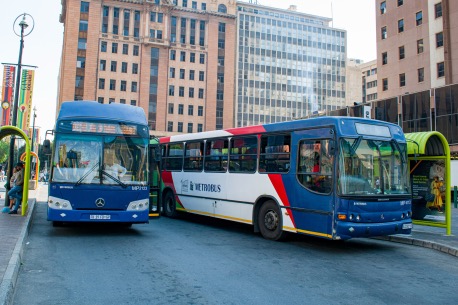
Queen Baloyi
The Eye on the Bus initiative has since its inception brought about significant improvements in safety, operational efficiency, and accountability within the Johannesburg Metro-Bus system. It is a cornerstone of efforts to enhance the City’s urban transportation landscape.
“By providing real-time surveillance and incident monitoring, the project ensures that the safety of both passengers and drivers becomes the top priority,” says Annlyn Seafield, the Project Manager for the Eye on the Bus initiative.
Key to the success of the initiative is its incident capture technology, which records footage of various incidents, such as accidents, assaults, and thefts. This visual evidence has been crucial in conducting investigations and legal processes, resulting in quicker resolution of disputes and improved justice for victims.
One of the most significant advantages of the Eye on the Bus system is its ability to capture and relay real-time data. This data encompasses everything from passenger numbers and bus locations to driver behaviour, offering the Johannesburg Metropolitan Trading Company (MTC) a level of insight previously unattainable.
This real-time information has enabled operational enhancements across the entire Metro Bus fleet. For example, by monitoring driver performance and passenger flow, the system allows for immediate adjustments to routes or schedules, ensuring that buses run efficiently and with optimal safety measures in place. The deterrent effect of having cameras aboard also plays a major role in reducing criminal activity. Knowing they are under constant surveillance; potential wrongdoers are dissuaded from committing crimes on the bus network.
“The combination of surveillance and real-time data capture makes it possible to deliver more reliable, efficient public transportation, enhancing the quality of service for the City’s commuters,” Seafield explains.
As with any ambitious project, Eye on the Bus encountered its fair share of challenges. One of the most significant hurdles was ensuring widespread adoption of the new technology among Metro Bus staff. Change management proved essential to the project’s success, as the MTC had to engage in comprehensive efforts to build confidence among drivers, administrative personnel, and labour unions.
By offering training sessions and open forums for communication, the MTC was able to address concerns and demonstrate the long-term benefits of the system. “This approach facilitated the smooth integration of the Eye on the Bus system into daily operations, with drivers and staff now relying on its capabilities to make their work more efficient and secure.”
While the Eye on the Bus system has shown incredible promise, it has not been without its technological challenges. One of the primary issues encountered has been the system’s reliance on Global System for Mobile (GSM) connectivity. In certain areas of Johannesburg, particularly those with less robust network coverage, maintaining consistent connections has proven difficult. This has at times, affected the reliability of real-time data transmission and device availability.
To counter these obstacles, the MTC has allocated resources to monitor network performance and implement strategies for ensuring that data continues to flow smoothly across the system. In addition, technical teams work around the clock to address software glitches and update the system as necessary to enhance overall reliability.
One exciting avenue for future development involves integrating the Eye on the Bus system with other municipal infrastructure systems, such as traffic management and public safety networks. By creating a more interconnected urban management system, the MTC aims to streamline operations across the board. This integration could lead to improved coordination between buses and other elements of the City’s transportation grid, reducing congestion and making routes more efficient.
“The MTC is also exploring how advanced analytics can be used to extract even deeper insights from the vast amounts of data collected by the Eye on the Bus system. By employing machine learning and artificial intelligence (AI) techniques, the MTC could gain a better understanding of commuter trends, route efficiency, and driver performance.”
These insights would not only improve current operations but could also inform long-term strategic planning. For example, by identifying patterns in commuter behaviour, the City could adapt routes or schedules to better serve Joburg’s growing population.
Since its rollout, public perception of the Eye on the Bus project has been overwhelmingly positive. “Many commuters have expressed their appreciation for the increased safety and transparency that the system offers. The presence of surveillance cameras alone provides a sense of security for passengers, especially during early morning and late-night routes.”
SOURCED FROM THE JOBURG WEBSITE.

